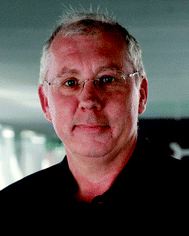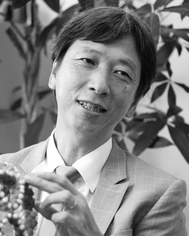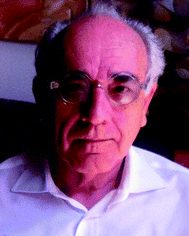Molecular containers
Pablo
Ballester
ab,
Makoto
Fujita
c and
Julius
Rebek
Jr.
de
aInstitute of Chemical Research of Catalonia (ICIQ), Av. Països Catalans 16, E-43007, Tarragona, Spain. E-mail: pballester@ICIQ.ES
bICREA, Passeig Lluis Companys 23, 08010 Barcelona, Spain
cDepartment of Applied Chemistry, Graduate School of Engineering, The University of Tokyo, 7-3-1 Hongo, Bunkyo-ku, Tokyo 113-8656, Japan. E-mail: mfujita@appchem.t.u-tokyo.ac.jp
dDepartment of Chemistry, Fudan University, 220 Handan Road, Shanghai, 200433, China
eSkaggs Institute for Chemical Biology, The Scripps Research Institute, and Department of Chemistry, 10550 North Torrey Pines Road, La Jolla, CA 92037, USA. E-mail: jrebek@scripps.edu
This special issue on Molecular Containers is about molecules in small spaces, spaces barely big enough to accommodate them. The spaces are provided by uni- or multimolecular containers – structures of various sizes, shapes and chemical surfaces – that offer recognition features for the molecules held inside. The containers may be covalently bound and therefore permanent, or spontaneously assembled through metal/ligand interactions, hydrogen bonds or hydrophobic forces and more or less temporary. As in macroscopic architecture, the spaces provided by the molecular containers determine what goes inside and what goes on inside. The covalent or supramolecular nature of the container is key in controlling the dynamics by which molecules can enter and leave its inner space. The interactions between the container and the contained molecules are prearranged, prolonged and private: the shape of the space determines the arrangement of molecules inside. In the specific case of fully closed supramolecular containers or containers featuring only one narrow open end, the lifetime of the container defines the length of the encounters. The impermeable parts of these containers completely isolate the encapsulated molecules from the bulk solution. Containers with large portals allow the entrance and release of molecules without requiring a significant change in their structure. The surface of the included molecules is partially isolated from the solvent.
In general, molecules inside containers behave quite differently from those in solution, where encounters are random, short-lived and constantly saturated by a swirling sea of solvent. When metal centers are incorporated in the cavities of the containers the catalytic properties are enhanced and modified compared to those expressed in the bulk. The differences in behavior are why we study molecules in containers: they comprise new conformations and stereochemical relationships; new reactions and accelerated old reactions; long-lived or stabilized “reactive” intermediates, and catalysis. Some of these behaviors are familiar features of nature's container molecules, enzymes and receptors. They also surround their molecular targets, isolate them from the aqueous medium, place them in a shaped space for relatively long times and present them with functional groups. But, as we shall see, inside the synthetic containers there are phenomena unknown to biology or solution chemistry and molecular structures that cannot be seen any other way.
Dariush Ajami, Lijuan Liu and Julius Rebek (DOI: 10.1039/c4cs00065j) report on reversibly formed containers and contained molecule shapes that are emergent. That is, neither exists independent of the other, but together they make stable complexes. They refer to these systems as “soft templates”.
Kenji Kobayashi and Masamichi Yamanaka (DOI: 10.1039/c4cs00153b) trace the use of a popular module for molecular containers: calix[4]resorcinarenes. These molecules, introduced some 35 years ago, have provided the curvature for covalent, hydrogen-bonded, hydrophobic and metal/ligand capsule shells. They include containers with large openings that permit parts of guest molecules to be inside and outside at the same time.
Jean-Noël Rebilly, Benoit Colasson, Olivia Bistri, Diana Over and Olivia Reinaud (DOI: 10.1039/c4cs00211c) report on biomimetic compounds generated by surrounding metal complexes by cavitand container molecules. The arrangements expand the coordination spheres of the metals to a 3rd level, and place the catalytic ion in a hydrophobic environment, in spite of the surrounding water solvent.
Dong Sub Kim and Jonathan L. Sessler (DOI: 10.1039/c4cs00157e) illustrate the use of molecular containers based on calix[4]pyrrole scaffolds as carriers for ion-transport through membranes and in the construction of stimuli-responsive supramolecular materials.
The review by Jacobs H. Jordan and Bruce C. Gibb (DOI: 10.1039/c4cs00191e) focuses on water-soluble molecular containers. It describes examples of supramolecular containers that are self-assembled in water solution through the exquisite use of the hydrophobic effect.
Liat Avram and Yoram Cohen (DOI: 10.1039/c4cs00197d) survey the use of diffusion ordered NMR spectrosocopy (DOSY) for the detailed study and characterization of a wide variety of molecular containers in solution.
Zhenhui Qi, Thomas Heinrich, Suresh Moorthy and Christoph A. Schalley (DOI: 10.1039/c4cs00167b) describe recent advances on the use of mass spectrometry for the investigation of molecular containers and their complexes both in solution and in the absence of any environment. The work focuses on chemical questions that can be answered with the appropriate use of the technique.
Keith Hermann, Yian Ruan, Alex M. Hardin, Christopher M. Hadad and Jovica D. Badjić (DOI: 10.1039/c4cs00140k) summarize the construction and mechanism of action of gated molecular containers. These hosts represent ideal model systems for studying the process of gating in synthetic systems.
Khaleel I. Assaf and Werner M. Nau (DOI: 10.1039/c4cs00273c) discuss fundamental host–guest properties of a young family of molecular containers: the cucurbit[n]urils (CBn) and cyclic derivatives. The synthesis of these unimolecular containers and their applications in the areas of molecular sensing and supramolecular catalysis are also surveyed.
Stefan H. A. M. Leenders, Rafael Gramage-Doria, Bas de Bruin and Joost N. H. Reek (DOI: 10.1039/c4cs00192c) present several supramolecular strategies for the encapsulation of transition metal complexes in the interior of molecular containers. The aim of the work is to control the catalytic properties of the metal center via second sphere coordination.
Salvatore Zarra, Daniel M. Wood, Derrick A. Roberts and Jonathan R. Nitschke (DOI: 10.1039/c4cs00165f) report on different applications of coordination-driven self-assembled molecular containers in the context of complex chemical systems. They focus on three main aspects: host–guest complex behavior, adaptive structural transformations and the modulation of chemical reactivity by encapsulation.
Putting together this special issue has been a completely new experience for us. We are indebted to all of those contributing. Their contributions demonstrate that the investigations on molecular containers and their applications constitute a vibrant and active field of research. We are convinced that this issue will be of interest to supramolecular practitioners and non-specialized chemists alike and we expect it to be useful not only for graduate students involved in this research but also for teaching at the undergraduate level.
| This journal is © The Royal Society of Chemistry 2015 |



